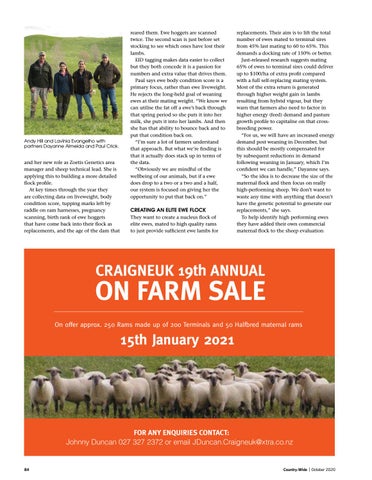Andy Hill and Lavínia Evangelho with partners Dayanne Almeida and Paul Crick.
and her new role as Zoetis Genetics area manager and sheep technical lead. She is applying this to building a more detailed flock profile. At key times through the year they are collecting data on liveweight, body condition score, tupping marks left by raddle on ram harnesses, pregnancy scanning, birth rank of ewe hoggets that have come back into their flock as replacements, and the age of the dam that
reared them. Ewe hoggets are scanned twice. The second scan is just before set stocking to see which ones have lost their lambs. EID tagging makes data easier to collect but they both concede it is a passion for numbers and extra value that drives them. Paul says ewe body condition score is a primary focus, rather than ewe liveweight. He rejects the long-held goal of weaning ewes at their mating weight. “We know we can utilise the fat off a ewe’s back through that spring period so she puts it into her milk, she puts it into her lambs. And then she has that ability to bounce back and to put that condition back on. “I’m sure a lot of farmers understand that approach. But what we’re finding is that it actually does stack up in terms of the data. “Obviously we are mindful of the wellbeing of our animals, but if a ewe does drop to a two or a two and a half, our system is focused on giving her the opportunity to put that back on.”
CREATING AN ELITE EWE FLOCK They want to create a nucleus flock of elite ewes, mated to high quality rams to just provide sufficient ewe lambs for
replacements. Their aim is to lift the total number of ewes mated to terminal sires from 45% last mating to 60 to 65%. This demands a docking rate of 150% or better. Just-released research suggests mating 65% of ewes to terminal sires could deliver up to $100/ha of extra profit compared with a full self-replacing mating system. Most of the extra return is generated through higher weight gain in lambs resulting from hybrid vigour, but they warn that farmers also need to factor in higher energy (feed) demand and pasture growth profile to capitalise on that crossbreeding power. “For us, we will have an increased energy demand post weaning in December, but this should be mostly compensated for by subsequent reductions in demand following weaning in January, which I’m confident we can handle,” Dayanne says. “So the idea is to decrease the size of the maternal flock and then focus on really high-performing sheep. We don’t want to waste any time with anything that doesn’t have the genetic potential to generate our replacements,” she says. To help identify high performing ewes they have added their own commercial maternal flock to the sheep evaluation
19th On offer approx. 250 Rams madeANNUAL up of 200 Terminals 50 HalfbredRAM maternal rams CRAIGNEUK 16th ONandFARM SALE
(on offer 260 Rams made up of 200 Terminals and 60 Halfbred maternal rams)
15th January 2021 12th January 2018
84
Country-Wide
October 2020
